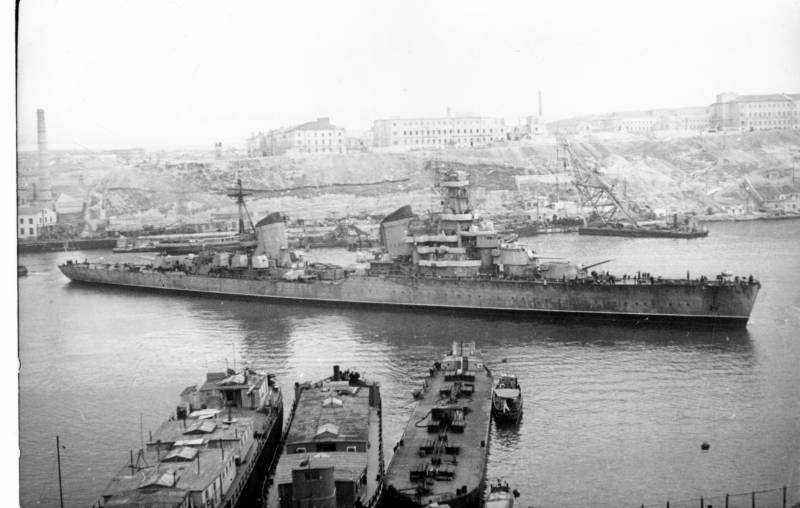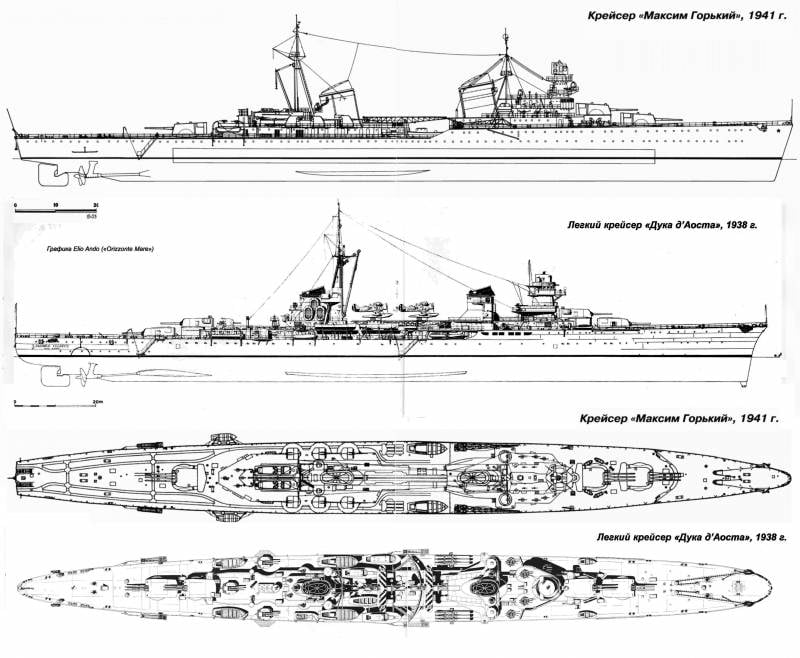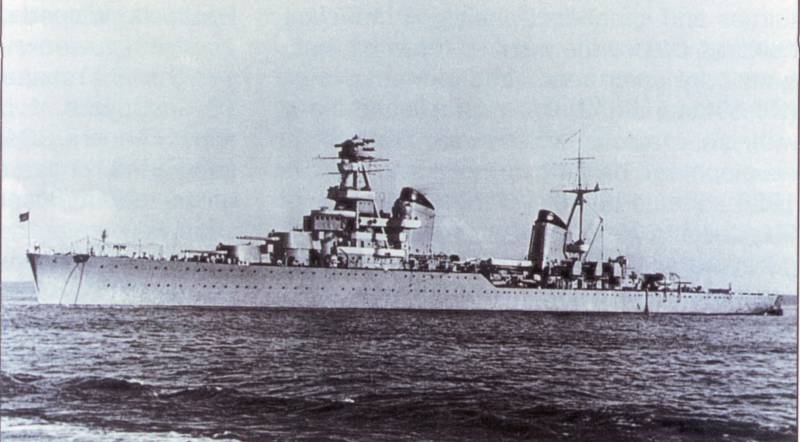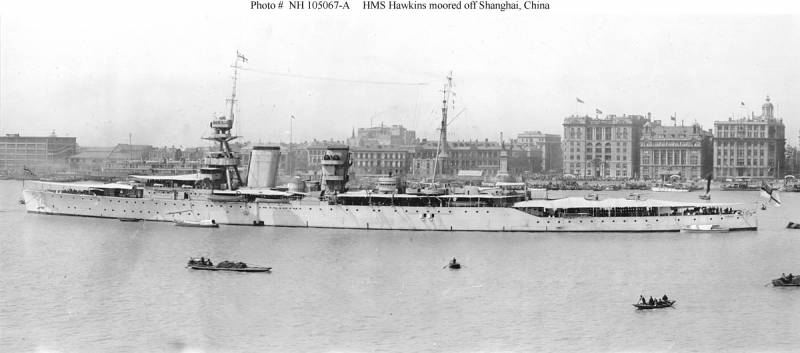Project 26 and 26 bis cruisers. Part of 2. “Italian footprint” and classification features
In this article, we will try to deal with the degree of participation of Italian specialists in the creation of the 26 and 26-bis cruisers, as well as with the position of the Soviet cruisers in the 30 international classification of the last century.
To begin with, let's refresh in our memory the “major milestones” of designing cruisers like the Kirov and Maxim Gorky.
15 April 1932 city approved the first operational technical task (HTA) of the cruiser.
July-August 1932 - A Soviet commission was sent and worked to Italy, whose task was to familiarize with the Italian shipbuilding industry, to select a prototype for the Soviet cruiser and to purchase a boiler-turbine power plant with a capacity of 100-120 thousand hp. The choice was made in favor of the Montekukkoli cruiser, and the commission offered to purchase a theoretical drawing and power plant of the latter.
19 March 1933 year approved the revised version of the "HTP" with the mechanisms (turbines) of the Italian cruiser "Montekukkoli". In accordance with the new HTA, the leadership of the Maritime Administration of the Red Army entrusts the Research Institute of Military Shipbuilding (NIVK) with the development of a draft design of the ship.
April 20 1933 years draft design NIVK approved.
8 May 1933 city The Red Army UMC leadership concluded an agreement with the Central Design Bureau for Shipbuilding (in other sources, “Special Shipbuilding”) of TsKBS-1 for the creation of a common (technical) cruiser project.
July 11 1933 city The Council of Labor and Defense approves the “Program of Naval Shipbuilding for 1933-1938”, which provided for the construction of eight light cruisers for the Baltic, Black Sea and Pacific fleets.
14 May 1934 city An agreement was signed between the Italian firm Ansaldo and TsKBS-1 for which the Italians (among other things) pledged to supply the power plant of the Eugenio di Savoy cruiser and a complete set of documentation for setting up the production of such plants in the USSR. From this point on, Italian specialists are directly involved in the design of the 26 cruiser.
By September 1934 NIVK succeeds in developing a new conceptual design, according to which it is impossible to “lay” the 26 cruiser of the 6 project into the standard displacement of 500 t, and that the cruiser will turn out when the standard displacement increases to 6 970 t. technical project
In October 1934 Head of the development of the towers of the main caliber A.A. Florensky proposed to place in the turret of the 26 cruiser of the project not two, but three guns.
In November, the 1934 TsKBS-1 presented the technical design. However, the results of TsKBS-1 turned out to be even more discouraging - according to the presented calculations, the standard displacement of the cruiser should have reached 7 225 t, and the speed dropped to half a node. At the same time, insufficient booking and arming of the ship was noted.
5 November 1934 V. M. Orlov approves the replacement of two-gun towers with three-gun towers. At the same time, he sets the standard displacement of the 26 cruiser at the level of 7120 — 7170 t.
29th of December 1934 The Labor and Defense Council approves the final performance of the cruiser.
In the end, the 1934 (Unfortunately, there is no exact date. - Approx. ed.) The Ansaldo hands over to the Soviet side a theoretical draft of a cruiser that was tested in the Roman and Hamburg experimental basins.
The following is a revision of the draft cruiser by the TsKBS-1 and the laying of two ships of the 26 project in October 1935
20th of December 1936 The cruiser for the Baltic (the future Maxim Gorky) is being laid under the 26 project.
January 14, 1937 for the 26 project, a cruiser for the Black Sea (the future Molotov) is being laid.
In January, the 1937 the Kirov under construction is visited by the commander of the Red Banner Baltic Fleet L.M. Haller and proposes to alter the fighting and wheelhouse, as well as a number of other posts. In the future, there are ideas about improving body armor, etc.
В апреле 1937 года the final decision is made: the first two ships of the series (the Kirov and Voroshilov) are completed by the 26 project, and the two recently laid ships are completed by the 26-bis project - with enhanced armor and armament, an increased total fuel capacity and a modified superstructure.
June-August 1938 - Bookmark the last 26-bis cruisers (Kalinin and Kaganovich) for the Pacific fleet.
What did the Soviet cruisers end up with? Were they a copy of Italian, adjusted for 180-mm main caliber? Let's see the main tactical and technical characteristics of cruisers.
Of course, there is some “kinship” of the projects, but the differences between them are very large, and the matter is not limited to guns of the main caliber alone. For example, booking a Soviet and Italian cruisers has fundamental differences. The Italians staked on vertical protection and placed spaced booking on their ships (in addition to belt armor, also an armored partition to “catch” fragments from projectiles that pierced the main armor belt), but their horizontal defense was not good. Soviet cruisers, on the contrary, receive a very powerful armored abutment, which at the time of design is superior to that of almost all light cruisers of the world, but they refuse a spaced reservation of the board, limited to armored belts of moderate thickness. Interestingly, the Italians, providing a very good booking of the board, for some reason ignored the traverses, which they received significantly weaker protection: so the Eugenio di Savoy board was covered with an 70-mm belt and behind it also a 30-35-mm bulkhead , while the beam has only 50 mm of thickness. It is a rather strange decision, taking into account the fact that light cruisers are characterized both by a counter battle on converging courses, and a battle on departure, when booking the extremities is most essential. Soviet cruisers are more logical in this respect - the thickness of the onboard and traverse armor is the same.
There are other differences: the Soviet cruisers have a smaller displacement, but they have more fuel on them (if you compare the Kirov and the Montecuccoli and Eugenio di Savoy with the Maxim Gorky). The design of hulls differs, and even the geometric dimensions of the ships do not match. And it would be fine if the dimensions of the Soviet cruisers were proportionally smaller than the Italian ones, which would be completely explained by the smaller displacement of domestic ships. No, the Soviet cruisers are longer and wider than the Italian ones, but the draft of the Montekuccoli and Eugenio di Savoy is greater. Someone may say that several meters of length and several tens of centimeters of precipitation do not play a role, but this is not so - such changes substantially change the theoretical drawing of the ship.
We will look at the differences between the Italian and Soviet cruisers in more detail in the design description of the cruisers of the 26 and 26-bis projects, but for now let us just note that neither the Kirov nor the Maxim Gorky are tracing paper overseas ships. We add that both the Italian and Soviet cruisers visually also had considerable differences:
But if “Kirov” is not the “180-mm copy” of “Montecuccoli” or “Eugenio di Savoia”, what is the role of the Italians in the creation of the Soviet cruiser? Here, unfortunately, there are a lot of questions that are waiting for their thoughtful researcher. History 26 project cruisers' design has been described many times, but very clearly, with various sources largely contradicting each other. That would seem to be a rather simple question: it is well known (and confirmed by all sources) that the power plant (EI) for our cruisers was acquired in Italy. But from which cruiser? After all, the EC "Montekuccoli" and "Eugenio di Savoia" differed from each other. A. Chernyshev and K. Kulagin in their book "Soviet Great Patriotic Cruisers" claim that the USSR bought the installation of the cruiser Eugenio di Savoia. But if we open the Encyclopedia of the Second World War cruisers. Hunters and Defenders "and see the section of Soviet cruisers (author - S. V. Patyanin), then we are surprised to find that the electric cruiser" Montekukkoli "was acquired. And, for example, A.V. Platonov, in his works, completely ignores this question, limiting himself to the phrase “the main power plant was purchased in Italy” without further specification.
The original documents could give answers, but unfortunately, it’s not so easy to find them: the author of this article could not find the text of the Ansaldo contract from 11 in May 1934. However, we have the “Help of the Shipbuilding Directorate of the UVKA RKKA about cooperation with the Italian company "Ansaldo" in the field of shipbuilding "from 11 in May 1934 g (i.e., drawn up three days before signing the contract - auth.) signed by the Head of the Shipbuilding Directorate of the UVMS RKKA Sivkov (hereinafter referred to as" Reference "). It says:
Ii. In the development of the contract the company will supply:
a) A complete set of main and auxiliary mechanisms - boilers, turbo and diesel dynamos, mine compressors, air-refrigerating machines, steering gear and other small mechanisms of the machine-boiler installation, completely identical to those of the Italian cruiser "E. di Savoia ", with all the working drawings, calculations and specifications for the electromechanical part. The mechanisms of this ship are the most modern in the Italian fleet and are manufactured by the company now for the nodal cruiser in the 36,5 building with a displacement of 6950 t.
b) Technological assistance on the production of the above mechanisms at the plants of the USSR, both in terms of metallurgy and in terms of machining and installation. Technological assistance will consist in transferring to the USSR plants all technical process data, supplying calibers, templates, devices and devices necessary for manufacturing these mechanisms, sending their highly qualified engineers (18 24) and technicians to the USSR to train and direct the work of our plants and, finally, training our engineers (12) and workers (10) in their factories.
c) A set of drawings, calculations and specifications for the hull part of the Montecuccoli cruiser, one of the newest cruisers of the Italian fleet entering 1935, as well as theoretical drawings and propellers for the cruiser and destroyer we designed. ”
Thus, it can be argued that the USSR acquired a complete set of power plant with all auxiliary mechanisms from Eugenio di Savoia (as evidenced by the similar capacity of the EU in this Italian and Soviet cruisers), while the Italians pledged to organize the production of similar plants in the Soviet Union . But then everything is again not clear: the document clearly states about the acquisition of “drawings, calculations and specifications” of the Montecuccoli hull, why then many authors (A. Chernyshev, K. Kulagin and others) indicate that the theoretical drawing of the cruiser Kirov was a revised version of the “Eugenio di Savoia”? How can this be explained?
It is possible that at the last moment, or even after the conclusion of the contract, it was decided to replace the “Montecuccoli” drawings with the “Eugenio di Savoy” drawings. But some phrases of the above “Help” hint that the sale of the theoretical drawing of the Italian cruiser is only part of the deal, and besides that the Italians have undertaken to create a new theoretical drawing for a specific project of the Soviet ship. Pay attention to: "... as well as theoretical drawings and drawings of propellers for the cruiser we designed ..." In addition, the fourth section of the "Reference" reads:
Apparently, the theoretical design of the 26 cruisers was made on the basis of the “Eugenio di Savoia”, but it’s not clear who made it, the Soviet designers or the Italian ones.
Under the contract with Ansaldo, the Italians sold us only the power plant and hull drawings, but it is well known that this did not exhaust the Soviet-Italian cooperation in the creation of 26 cruisers: Italian specialists helped us with the calculation of the weight characteristics of the cruiser, in addition, the towers The main caliber was also designed with Italian help. It is possible that we turned to Mussolini's shipbuilding companies and other technical issues. It can be assumed that a brief history of the design of Soviet cruisers looked like this: after the appearance of the first HTA (6 000 t, 4 * 180-mm guns), the USSR was able to get acquainted with the designs of the newest Italian cruisers, during which decisions were made to purchase the Montecucoli power plant "And installation on the Soviet ship of the third tower of the main caliber. Accordingly, domestic designers created a draft design of a cruiser with a displacement of 6 500 t and carrying 6 * 180-mm guns, and in parallel with this, negotiations were underway to purchase the undercarriage and technical assistance of the Italians. In May, 1934 signed an agreement with Ansaldo, and the Soviet side declares its desire to build a cruiser in 7 000 t (here apparently insured against the case of a further increase in displacement). The Italians considered that the theoretical design “Eugenio di Savoia” was best suited as the basis for the design of the new Soviet ship, and created the corresponding design - for the 7 000 t cruiser with three two-gun 180-mm turrets, and by the end of 1934 they "Run in" it in the European experimental pools. While the Italians were engaged in a theoretical drawing, the Soviet designers created the project (yet the internal structure of the compartments of the Soviet cruisers, not counting the boiler rooms and engine rooms, is very different from the Italian, if only because of different booking systems). Of course, in designing our design offices had the opportunity to consult with the Italians, but to what extent it is unclear. As a result, by the end of 1934, Italian theoretical drawings and Soviet studies were supposed to “merge” into a quality cruiser project in 7 000 T. Accident was prevented - just at the end of 1934 in the USSR, A.A. Florensky about replacing two-gun towers with three-gun towers, which required redesigning the towers, revising the hull structure and, of course, reworking the theoretical drawing created by the Italians, but the Soviet design bureau did this work almost independently. Why not ask the Italians? Most likely because they had already fulfilled their obligations and designed the cruiser at the request of the customer, and if the customer suddenly and at the final stage decided to revise the conditions, then the Italians could not be held responsible. At the same time, the level of Soviet design thought has already allowed solving such issues on its own.
It should be noted that, having made such a decision, the TsKBS-1 specialists fairly risked - the Italians vouched for achieving the contract speed only if the cruiser was built with an Italian chassis and according to the Italian theoretical design. Accordingly, having made changes to the latter, the specialists of TsKBS-1 took responsibility for themselves; now, in the event of a failure to reach the contract speed, it was they who were responsible, not the Italians. But for such a failure it was possible to please in the "enemies of the people."
And yet the cruiser type "Kirov" should be considered mainly Soviet development. Of course, the USSR took full advantage of the knowledge and shipbuilding experience of Italy, and this was absolutely correct. In the conditions of revolution, civil war and the extremely difficult economic situation of the country of the end of 20, the beginning of 30, the domestic shipbuilding industry could not develop, in fact it stagnated. And the leading naval powers at that time went into a technological breakthrough: the boilers and turbines of the 30s fundamentally surpassed everything that was created before the First World War, there were very sophisticated tower installations of medium-caliber artillery, stronger armor, etc. Keeping up with all this at the same time would be extremely difficult (although it is possible, for example, if we recall the power of the Leningrad leaders created in the USSR), so using someone else's experience was more than justified. At the same time, a very specific type of cruiser was created in the USSR, which corresponds to the Soviet naval doctrine and is completely dissimilar to the cruisers of other powers. One can argue for a long time about how true the prerequisites laid down in the HTA of the first Soviet cruiser were, but the specificity of the characteristics of the 26 and 26-bis project ships, which caused so much controversy about their "class" affiliation, cannot be denied.
So what kind of cruisers did the USSR have? Light or heavy? Let's try to understand the existing classifications in 30, defined by international maritime treaties.
In 1922, the five largest sea powers of the world (England, USA, Japan, France, Italy) signed the Washington Maritime Agreement, according to which the standard displacement of cruisers was limited to 10 000 "long" (or 10 160 metric) tons, and the caliber of the guns should not exceed 203 mm:
Article 11 of the Agreement stated: “Contracting parties may not acquire or build warships of other classes, except large ships and aircraft carriers, with a standard displacement exceeding 10 000 t, within their jurisdiction.”
Article 12 established: "Contracting ships, laid down in the future, except for large ships, should not carry tools of a caliber larger than 8 inches (203 mm)."
There were no other limitations or definitions for cruisers in this document. In essence, the Washington Agreement attempted to limit the construction of battleships and aircraft carriers, and both of the above articles are aimed at preventing member countries from building battleships under the guise of cruisers. But the Washington Agreement did not regulate the classes of cruisers in any way - do you want to consider the 203-mm ten thousand meters small or light cruisers? Your inalienable right. The agreement simply stated that a ship over 10 thousand tons or with artillery more than 203 mm would be considered a battleship, that's all. Interestingly, the first Italian “Washington” cruisers “Trento” and “Trieste” were considered light cruisers when laying in the 1925 g (although they were later reclassified into heavy ones). So from the point of view of the Washington Agreement, the Kirov-class can be safely attributed to light cruisers.
The London Maritime Treaty of 1930 is different. In the 15 article of the 3 section, two subclasses of cruisers were established, the belonging being determined by the caliber of the guns: the first subclass included ships with artillery over 155 mm and the second, respectively, with tools 155 mm or lower. Given the fact that the London Treaty did not cancel the Washington Agreement (according to the 23 article, it became null and void 31 December 1936) both cruiser subclasses could not be larger than 10 thousand tons of standard displacement.
Interestingly, France and Italy refused to sign the 3 section of the Treaty of London, which specified cruisers. Of course, the point was not at all in the classification, but in the fact that France and Italy sought to avoid restrictions on the tonnage of cruisers, destroyers and submarines, which were established by article 16 of the third section. Be that as it may, the full text of the treaty was signed only by three maritime powers - the USA, Great Britain and Japan. However, subsequently (Rome Pact 1931), France and Italy nevertheless agreed to recognize the third section of the London Maritime Treaty 1930, but then in 1934, Japan completely abandoned its implementation.
Despite these "throwing", it is likely that we can still assume that the London Maritime Treaty of 1930 gave the world classification of cruisers, but it should be borne in mind that the 3 section of this treaty (along with many others) as well as the Washington Agreement acted only until December 31 1936. So starting from 1 in January 1937, no document regulated the characteristics of cruisers, unless the countries gather again at an international conference and come up with something, but if they gather, and what they decide no one could have foreseen.
As is known, the USSR did not sign either the Washington Agreement or the 1930 Treaty of London of the year and was not obliged to fulfill their conditions, and the commissioning of the 26 Soviet cruisers was to be carried out (and actually implemented) only after these treaties became invalid.
The last prewar maritime agreement regulating the classes of surface ships (London Maritime Treaty 1936 of the year) cannot be considered international, since only three of the five major maritime powers were signed: the United States, Britain and France. But, although the USSR did not participate in the conference, he recognized its position, although later. This happened at the time of the conclusion of the Anglo-Soviet Maritime Agreement 1937, in which the Soviet Union undertook to adhere to the classifications of the London Maritime Treaty 1936. What were these classifications?
The very concept of "cruiser" did not exist in it. The 2 class of large artillery warships was distinguished - large surface ships of war (Capital ships and Light surface vessels). The first are the battleships, which in turn were divided into 2 categories:
1) the ship was considered a linkor of the 1 category if it had a standard displacement of more than 10 thousand "long" tons, regardless of what caliber the artillery was installed on it. Also, ships with a displacement from 1 to 8 thousand "long" tons belonged to the 10 category, if their artillery caliber exceeded 203 mm;
2) battleships of the 2 category were related to ships that had a standard displacement of less than 8 thousand "long" tons, but having more than 203-mm artillery.
What kind of battleship is less than 8 KT? Probably, in this way, they tried to isolate coastal defense battleships into a separate subclass.
Light surface ships had a standard displacement of no more than 10 thousand "long" tons and were divided into 3 categories:
1) ships whose guns were larger than 155 mm;
2) ships whose guns were equal to or less than 155 mm, and whose standard displacement exceeded 3 thousand "long" tons;
3) ships whose guns were equal to or less than 155 mm and whose standard displacement did not exceed 3 thousand "long" tons.
In a number of sources it is indicated that the second London gave a different definition to light cruisers and that those were considered those whose caliber of artillery did not exceed 155 mm, and the standard displacement - 8 thousand "long" tons. But judging by the text of the contract, this is a mistake. The fact is that the London Treaty of 1936 of the year forbade the construction of the “Light Surface Ships” of the first category (i.e., with tools over 155 mm) and allowed to build the 2 category, but only on condition that the standard displacement of such ships would not be exceed 8 thousand "long" tons. Those. if some power had cruisers with a displacement from 8 to 10 thousand tons with 155-mm artillery at the time of signing the contract, it was recognized as light (second category), but until the expiration of the contract it was forbidden to build light cruisers over 8 thousand displacement.
And what about our "Kirovs"? Obviously, from the point of view of the letter of the agreement, the cruisers of the 26 and 26-bis projects are heavy cruisers (the first category of Light Surface Ships). Nevertheless, the small standard displacement (for cruisers of the 26 project - 7880 metric tons) was within the limits allowed for construction. Therefore, in the process of agreeing the Anglo-Soviet Maritime Agreement, the USSR notified England that the new Soviet cruisers are light and have a displacement of less than 8 thousand "long" tons, but at the same time carry the 180-mm gun.
In essence, for our cruisers came the “moment of truth”: they really differed from everything that the leading maritime powers built, and their position in the cruising “table of ranks” remained unclear. Now, however, it was necessary to decide whether they were light or heavy (more precisely, whether they belong to the first or second category of “light warships” of the London Treaty of 1936), and the question was extremely important. The fact is that if the 26 project cruisers were recognized as heavy, their construction, in accordance with the 1936 Treaty of London, should have been banned. It is clear that the USSR would not disassemble the four cruisers under construction, but it was possible to prohibit the laying of such ships in the future or demand the replacement of 180-mm guns with 152-mm. References to the fact that the USSR did not have 152-mm artillery at that time should not be taken into account, since the very same England could provide at least some drawings, even ready-made cannons and turrets at the most reasonable price.
In order to fully understand what happened in the future, you need to consider the following. At that time, the UK economy was far from booming, and the new naval arms race was ruinous for it. That is why the British were so eager to conclude international treaties limiting the quantity and quality of warships of all classes. Only in this way could England remain the leading maritime power (accepting parity only with the United States).
However, the efforts of England disappeared in vain: Italy and Japan did not want to sign a new treaty, and thus the British, French and Americans found themselves in a position where the restrictions they had invented applied only to them, but not to their likely opponents. This put England, the United States and France at a disadvantage, but they still did it, and there was also hope that Japan and Italy would change their mind and join the second Treaty of London.
At the same time, the Anglo-Soviet treaty 1937 was only concluded between England and the USSR. And if it turned out that this agreement would in some way contradict the London Maritime Treaty of 1936, then the United States and France would receive the full right to immediately terminate the unprofitable agreement for them. Moreover, Italy and Japan could effectively use such a violation, declaring that England was persuading the leading maritime countries for the same conditions, but then, behind them, concludes treaties on completely different ones and that from now on England, as the initiator of international agreements, there is no trust and no can. Worse, the same could have been done by Germany, which quite recently (in 1935) entered into a maritime agreement with England, which the leadership of the latter tried to present to its people as a great political victory.
In other words, if England, when signing a naval treaty with the USSR, would in some way violate the London Treaty of 1936, all political efforts in the field of limiting naval armaments would have been dust.
England agreed to consider cruisers of the type "Kirov" permitted for construction. Thus, the British de jure recognized that despite the 180-mm caliber, the Soviet ships of the project 26 and 26-bis should still be considered light cruisers. At the same time, the British introduced only one, quite reasonable, condition: they insisted on limiting the number of such ships to quotas of heavy cruisers. The USSR received the right to build seven 180-mm ships - i.e. as much as there were 203-mm cruisers from France, to which the fleet was equated with the fleet of the USSR under the Anglo-Soviet agreement. It was logical, because if the number of Kirov-type cruisers allowed to be built was not limited, it turned out that the USSR received the right to build more powerful light cruisers than England, France and the USA.
Interestingly, neither the United States, nor France, and no one in the world tried to protest such a decision and did not consider the cruisers of the 26 and 26-bis project a violation of existing treaties. Thus, the international community agreed with the English interpretation and de facto recognized cruisers like the Kirov as light.
The question arises. If Soviet naval science and the international community have recognized the cruisers of the 26 and 26-bis projects are light, then what is the basis of modern historians to convert them into heavy subclasses? Still the same letter of the London Treaty on 155-mm caliber? And the excess of this parameter per inch automatically makes the "Kirovs" heavy cruisers? Well, then let's consider the question of classifying Soviet cruisers from a different point of view.
It is well known that the Washington restrictions of cruisers - 10 thousand tons and 203-mm caliber - did not arise as a result of the evolution of this class of ships, but in general by chance - at the time of the signing of the Washington agreements, England had the latest cruisers Hawkins in the fleet 9,8 thousand tons with seven 190-mm guns in deck installations, and it was clear that Britain would not send the newly built ships for scrapping.
At that time they were the largest modern cruisers and the Washington restrictions are oriented precisely on these ships. But the Hawkins, in spite of all its novelty, was the shipbuilding yesterday. On the approach were completely new types of ships, with turret artillery of the main caliber, which weighed a lot more deck installations. At the same time, the Hawkins were built as a fighter for light cruisers, and as such they carried extremely moderate protection, capable of covering the ship except from 152-mm projectiles of light cruisers. But to build the "Washington" ten-thousandths all rushed, respectively, the question of meeting cruisers in battle seriously arose, which required adequate protection from 203-mm projectiles.
Very quickly, shipbuilders around the world were convinced that the creation of a harmonious ship with 203-mm guns in the 10 160 displacement metric tons is impossible - fast-moving, but almost unprotected ships were obtained. Then almost all the fleets of the world went to the scam - they strengthened the performance characteristics of their ships, violating the Washington and London agreements on a displacement of one or two thousand tons, or even more. Italian "Zara"? Standard displacement - 11 870 tons. "Bolzano"? 11 065 tons. American "Wichita"? 10 589 tons. Japanese "Nati"? 11 156 tons. "Takao"? 11 350 tons. "Hipper"? Generally 14 250 tons!
None of the above (and many others not mentioned in this list) ships, according to the current international classification is not a cruiser. All of them, having a standard displacement of more than 10 000 "long" (10 160 metric) tons, are ... battleships. Therefore, focusing on the letter of the contract, of course, one can recognize the Soviet cruisers of the 26 and 26-bis projects as heavy. But in this case it is completely senseless to compare ships of completely different classes, which, from the point of view of the London Maritime Treaty 1936, are the heavy cruiser Kirov and, for example, the battleship Zara or Admiral Hipper.
The question is not in chicory, but in the fact that situations with violation of international treaties are absolutely identical. In the Soviet Union, a light cruiser was designed, but it was considered that the 180-mm caliber responded better to its tasks and thus exceeded the limits for light cruisers according to international classification. In Italy, designed the heavy cruiser "Zara" and, to make it more balanced, increased the displacement than exceeded the limits for heavy cruisers according to the same international classification. Why do we have to transfer the cruiser "Kirov" to the next subclass of cruisers, but at the same time leave the "Zara" in its class?
To be continued ...






Information